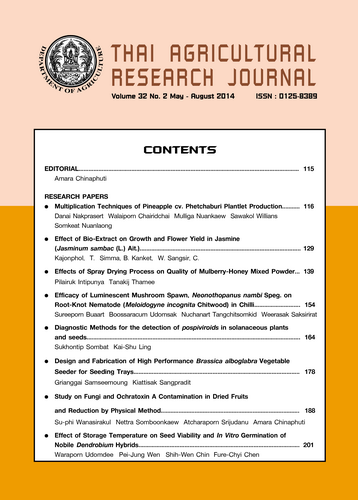Diagnostic methods for the detection of pospiviroids in Solanaceous plants and seeds
DOI:
https://doi.org/10.14456/thaidoa-agres.2014.6Keywords:
detection, Pospiviroids, Solanaceae, Potato spindle tuber viroidAbstract
In many countries phytosanitary regulations were applied to pospiviroid, Potato spindle tuber viroid (PSTVd) because it can cause economically important diseases on Solanaceous plants and seeds. Consequently, there is a need for a reliable and costeffective generic testing method. PSTVd infected tomato seeds from North Carolina, USA were used for evaluation the PSTVd detection method in U.S. vegetable laboratory, South Carolina. Total seed RNA was prepared using Trizol reagent and SDS- potassium acetate methods. PSTVd can be detected by RT-PCR and Real time RT-PCR from single infected seed. Real time RT-PCR was highly sensitive and effective. It can be detected from mixture of a single infected seed and healthy seeds in various ratios of tomato and Solanaceous seeds with two extraction methods. An initial investigation of PSTVd in tomato breeder stock seed srevealed the presence of the viroid at greenhouse in the North Carolina area. PSTVd infection in solanaceous plants that were inoculated with sap from tomato infected seeds displayed severe symptoms in tomato plants, very mild symptoms in pepper plants and symptomless in petunias plants at eight weeks after inoculation.
Downloads
Published
How to Cite
Issue
Section
License
Copyright (c) 2017 วารสารวิชาการเกษตร (Thai Agricultural Research Journal)

This work is licensed under a Creative Commons Attribution-NonCommercial-NoDerivatives 4.0 International License.
Thai Agricultural Research Journal



